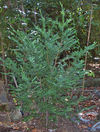Genus Prumnopitys
Prumnopitys is a genus of conifers belonging to the podocarp family Podocarpaceae.Species in the genus Prumnopitys of plants
Prumnopitys andina - It grows up to 30 m high, with a trunk up to 2 m diameter . The leaves are linear to sickle-shaped, 15–30 mm long and 2 mm broad. The seed cones are highly modified, reduced to a central stem 2–4 cm long bearing 1-4 scales, each scale maturing berry-like, oval, 10–15 mm long and 10 mm broad, green maturing dark purple, with a soft edible pulp covering the single seed. The seeds are dispersed by birds, which eat the 'berries' and pass the seeds in their droppings. Seeds are very difficult to germinate. Straight and cylindrical trunk. Gray and shine bark.
Miro - It grows up to 25 m high, with a trunk up to 1.3 m diameter. The leaves are linear to sickle-shaped, 15-25 mm long and 2-3 mm broad, with downcurved margins. The plants are dioecious with pollen cones being solitary while those of female plants hang from a curved, scaly stalk. The seed cones are highly modified, reduced to a central stem 2-3 cm long bearing 1-3 scales, each scale maturing berry-like, oval, about 20 mm long and 10-15 mm broad, red to purple-red with a soft edible pulp covering the single seed. The seeds are dispersed by the Kerer? , which eats the very conspicuous 'berries' and passes the seeds in its droppings. It is found growing on both lowland terrain and on hill slopes throughout the two main islands as well as on Stewart Island/Rakiura .
Prumnopitys harmsiana - It is a medium-sized tree similar to Prumnopitys andina. The leaves are 2–3 cm long and 2–3 mm broad, with a short spine tip. The cones are highly modified, bearing a few drupe-like seeds, each seed with a thin fleshy coat.
Matai - It grows up to 40 m high, with a trunk up to 2 m diameter. The leaves are linear to sickle-shaped, 10–15 mm long and 1.5–2 mm broad. The seed cones are highly modified, reduced to a central stem 3–4 cm long bearing 1-6 scales, each scale maturing berry-like, 10–15 mm long, violet-purple with a soft edible pulp covering the single seed. The seeds are dispersed by the Kerer? , which eats the 'berries' and passes the seeds in its droppings.

